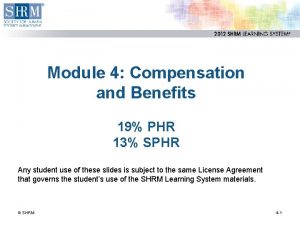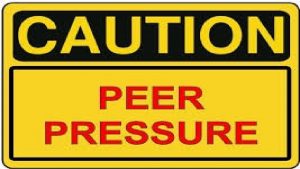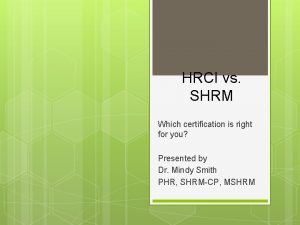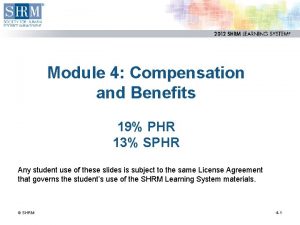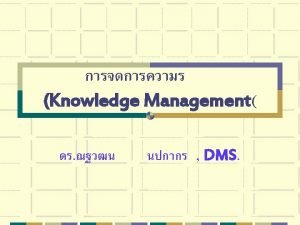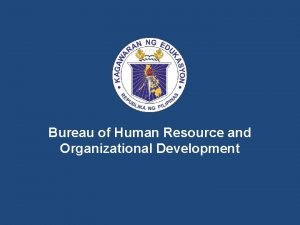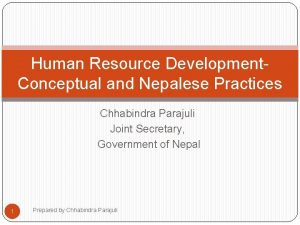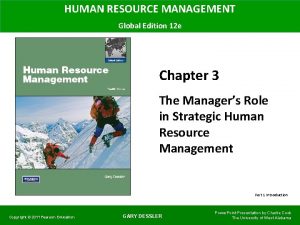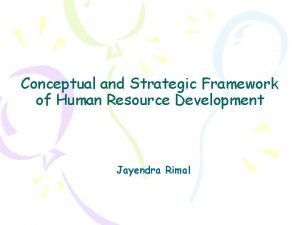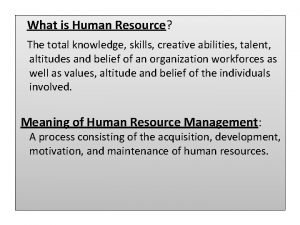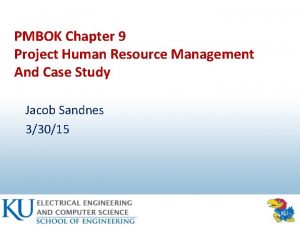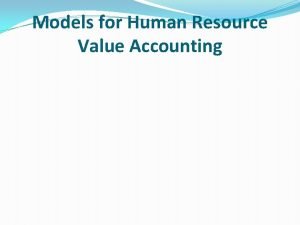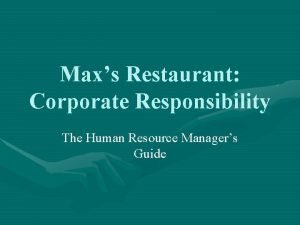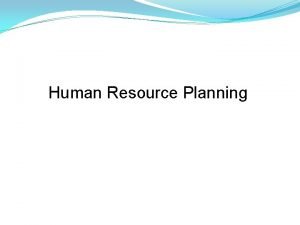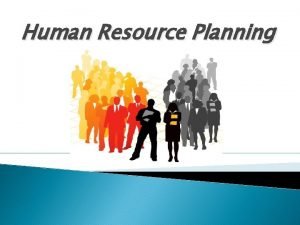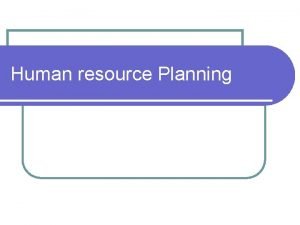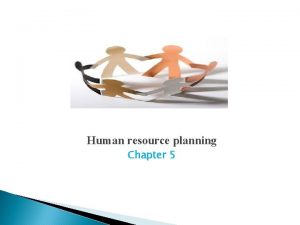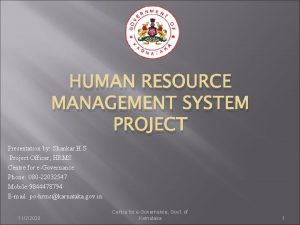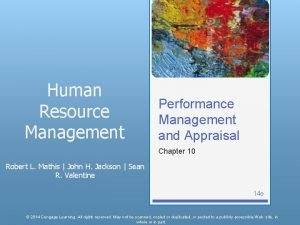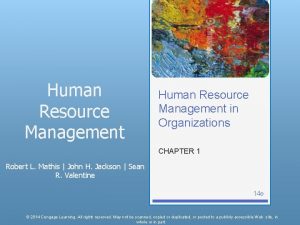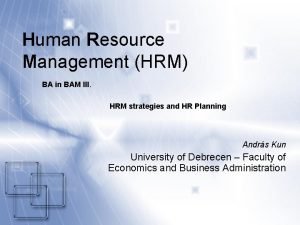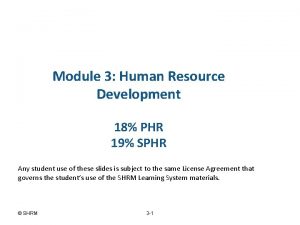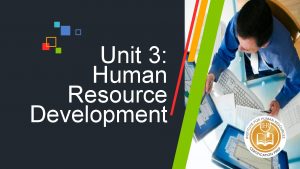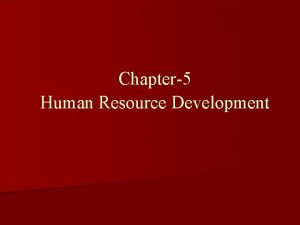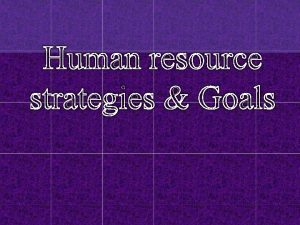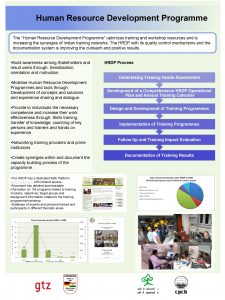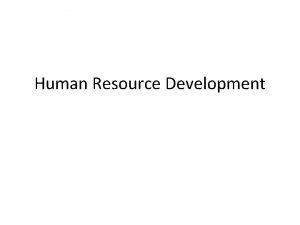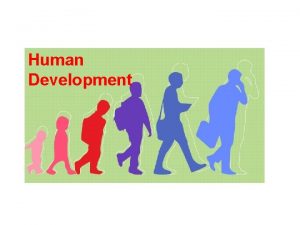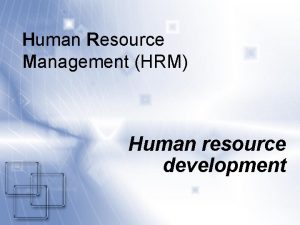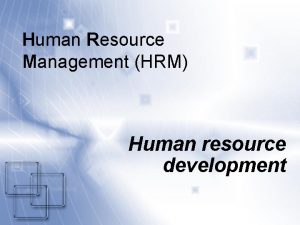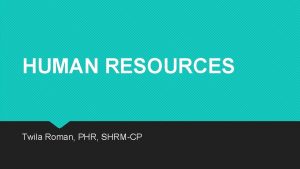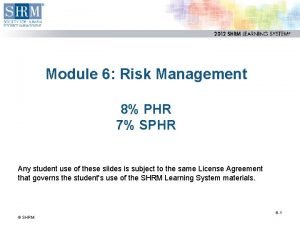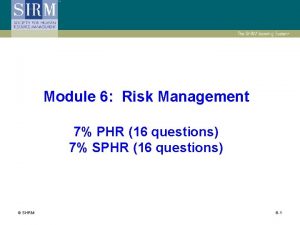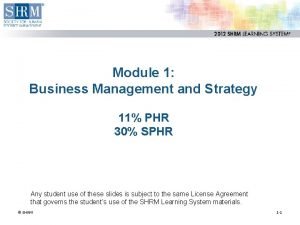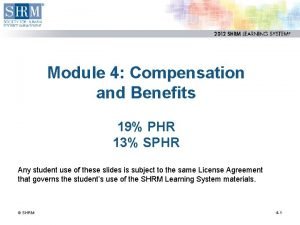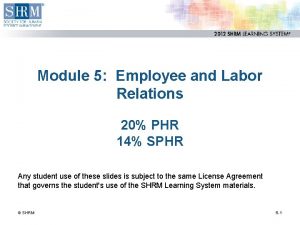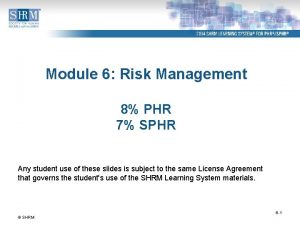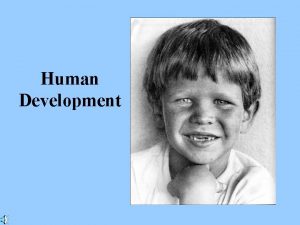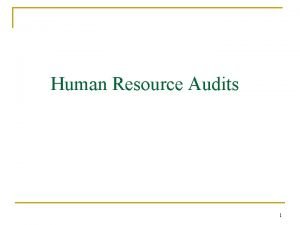Module 3 Human Resource Development 18 PHR 19









































- Slides: 41

Module 3: Human Resource Development 18% PHR 19% SPHR Any student use of these slides is subject to the same License Agreement that governs the student’s use of the SHRM Learning System materials. © SHRM 3 -1

HRD • Provides employees with the skills to meet current and future job demands. • Aligns HRD activities with organization's goals. Organizational strategic goals HRD activities Business results © SHRM 3 -2

An organization wants to reduce its research and development time by 50%. Which of the following training events is MOST closely linked to this corporate goal? A. B. C. D. Time management training Data collection and analysis training Leadership training Conflict resolution training © SHRM 3 -3

The Learning Organization is characterized by its capability to adapt to changes in its environment. Learning is accomplished by the organizational system as a whole. Systems thinking is practiced. Employees network internally and externally. Change is embraced. Failures become opportunities to learn. © SHRM 3 -4

Which of the following occurs in a learning organization? A. The organization selects people who will receive training. B. Emphasis is on team learning, not individual learning. C. Learning is connected to organizational goals. D. Each employee creates his or her own vision of the organization. © SHRM 3 -5

Knowledge Management Focuses on: • Expertise sharing and organizational learning. • Knowledge retention and recovery of knowledge lost due to employee attrition. © SHRM 3 -6

Global Impact on HRD SPHR only • Organizational change and knowledge management become more complex. • Western motivation models may not apply. • Demand for multilingual/multicultural training increases. • Focus may be less on knowledge and skills than on power of relationships, awareness, mindsets, and personal networks. • Talent management and retention increase in importance. © SHRM 3 -7

Hofstede’s Value Dimensions SPHR only Culture affects training topics and methods. • Power distance (extent to which less-powerful members of organizations accept that power is distributed unequally) • Uncertainty avoidance (extent to which people cope with anxiety by minimizing uncertainty) • Individualism/collectivism (extent to which people stand up for themselves and choose their affiliations) • Masculinity/femininity (value placed on traditional male or female roles in Western cultures) • Long-term/short-term view (extent to which society embraces long-term commitments and tradition) © SHRM 3 -8

Low- and High-Context Cultures SPHR only Low-Context Culture High-Context Culture Communication is direct, structured, and specific. Shared background is not assumed. Communication is less clear because of common understandings and a shared culture. A higher value is placed on the words spoken than on the nonverbal communication. Meanings are derived from nonverbal communication. Behavior and beliefs are spelled out explicitly. Face-saving and tact are balanced with the need to communicate fully and frankly. © SHRM 3 -9

Copyright Act • Protects literary, artistic, or other creative expression. • Protects the author’s right to reproduce, distribute, or perform copyrighted work. • Introduces the concepts of public domain and fair use. © SHRM • Person who creates a work generally owns the copyright, except for work-made-for-hire exceptions such as: – Works created by employees. – Works specially ordered or commissioned. 3 -10

Which of the following is a work that has fallen into the public domain? A. A pop song written in 1980 B. An article in an HR magazine C. An HR textbook revised in 1997 D. A government pamphlet © SHRM 3 -11

Under the fair-use standard, trainers may A. copy a Learning System module for a friend. B. cite and copy a paragraph from an article and pass it out at a staff meeting. C. copy a chapter from an HR textbook and hand it out to a class. D. copy any materials for a free training session. © SHRM 3 -12

Equal Access to Training • Equal access to training and career development is guaranteed by: – Title VII of the Civil Rights Act of 1964. – Uniform Guidelines on Employee Selection Procedures. – Americans with Disabilities Act (ADA). – Age Discrimination in Employment Act (ADEA). – Uniformed Services Employment and Reemployment Rights Act (USERRA). © SHRM 3 -13

Organizational Culture Shared values and perceptions that: Give members an organizational identity. Facilitate commitment. Shape behavior. © SHRM Promote system stability. Impact an organization’s success or failure. 3 -14

OD Intervention Process 3. Evaluate the results. 1. Diagnose the environment. HR roles: • Change agent • Evaluator 2. Develop an action plan. © SHRM 3 -15

OD Interventions Interpersonal Technological • Work relationships between employees • • Process analysis Job design Specialization Work-flow analysis Structural • Span of control • Reporting relationships Examples: Team building, flexible work and staffing, diversity programs, quality initiatives © SHRM 3 -16

Systems Theory • Applied in organizational development interventions. • Essential to the quality movement and leads to process improvement. • Based on understanding the relationship between three key components: © SHRM 3 -17

Process-Flow Chart © SHRM 3 -18

Control Chart © SHRM 3 -19

Cause-and-Effect Diagram © SHRM 3 -20

Scatter Diagram © SHRM 3 -21

Histogram © SHRM 3 -22

Pareto Chart © SHRM 3 -23

Six Sigma • Data-driven methodology for eliminating defects. • A process must not produce more than 3. 4 defects per million opportunities. • Six Sigma employees (Green Belts) and project leaders (Black Belts) are overseen by quality leaders (Master Black Belts). © SHRM 3 -24

Adult Learning Principles Adults want training that: • Focuses on “real world” issues. • Applies to their jobs. • Meets their goals and expectations. • Allows for debate and challenge of ideas. • Encourages an exchange of ideas and opinions. • Allows them to be resources to each other. • Meets a current need. © SHRM 3 -25

Which of the following is LEAST likely to affect a participant’s readiness to learn? A. Motivation B. Ability C. Tenure with the organization D. Perceptions of the work environment © SHRM 3 -26

Learning Styles Visual Auditory Kinesthetic © SHRM 3 -27

Retention will be increased by appealing to all learning styles. Approximate retention rate © SHRM 3 -28

Learning Curves Decreasing returns © SHRM Increasing returns 3 -29

Learning Curves S-shaped curve © SHRM Plateau curve 3 -30

Bloom’s Taxonomy Highest level of learning Lowest level of learning © SHRM 3 -31

Maslow’s Hierarchy of Needs © SHRM 3 -32

Herzberg’s Motivation-Hygiene Theory © SHRM 3 -33

Which of the following intrinsic factors affect an employee’s willingness to do the job? A. Opportunities for recognition and relationship with coworkers B. Opportunities for personal growth and achievement C. Working conditions and job security D. Job environment and pay © SHRM 3 -34

Mc. Clelland’s Theory High achievers: • Set moderately difficult but potentially achievable goals. • Prefer to work on a problem rather than leave the outcome to chance. • Seem to be more concerned with personal achievement than with the rewards of success. • Seek situations in which they get concrete feedback on how well they are doing with regard to their work. © SHRM 3 -35

Mc. Gregor’s Theory X and Theory Y (Rigid control) © SHRM Continuum (Autonomy) 3 -36

Vroom’s Expectancy Theory • Key variable is level of effort. • Decision to exert the effort depends upon three factors. © SHRM 3 -37

A first-line supervisor desires a management position. However, only college graduates seem to be promoted. The employee decides not to enroll in college since balancing work and school would be too hard. According to Vroom, the employee A. does not believe that a college degree will lead to a management job. B. does not want a management position badly enough. C. does not trust organizational management. D. lacks confidence in himself. © SHRM 3 -38

Adams’s Equity Theory Based on the fact that people want to be treated fairly. Inputs: effort, education, seniority = Outcomes: pay, status, benefits Tension exists when similar inputs do not equal similar outcomes. Employees may adjust their behavior or quit their jobs. © SHRM 3 -39

Skinner’s Behavioral Reinforcement Theory Positive Reinforcement Negative Reinforcement Person repeats desired behaviors to gain a desired reward. Person works to avoid an undesirable consequence. © SHRM Punishment Response causes something negative to occur. Extinction Unlearning undesired behavior because of no response or reinforcement. 3 -40

Applications of Motivational Theories Motivational theories are the basis for: • Positive reinforcement. • Design of work and work environment (intrinsic). • Goal setting. • Formal extrinsic rewards. • Pay-for-performance systems. © SHRM 3 -41
 Phr salary
Phr salary Spoken peer pressure
Spoken peer pressure Emr ehr phr
Emr ehr phr Phaol
Phaol Hrci vs shrm certification
Hrci vs shrm certification Mental health equity
Mental health equity Human resource development framework
Human resource development framework Human resource management exam questions
Human resource management exam questions Bhrod rpms
Bhrod rpms Conclusion for training and development ppt
Conclusion for training and development ppt Importance of human resource development in nepal
Importance of human resource development in nepal Hr strategy map
Hr strategy map Kasocs
Kasocs Human needs and human development
Human needs and human development Chapter 8 human needs and human development
Chapter 8 human needs and human development Human development index definition ap human geography
Human development index definition ap human geography Resource loading vs resource leveling
Resource loading vs resource leveling Perbedaan resource loading dan resource levelling
Perbedaan resource loading dan resource levelling C device module module 1
C device module module 1 Unpurchased goodwill method
Unpurchased goodwill method Zero-base forecasting
Zero-base forecasting Time management human resources
Time management human resources Project human resource management pmbok ppt
Project human resource management pmbok ppt Aboriginal human resource council
Aboriginal human resource council Resource management pmbok
Resource management pmbok Lev and schwartz model example
Lev and schwartz model example Importanceof hrm
Importanceof hrm Restaurant human resources
Restaurant human resources Human resource planning and retention
Human resource planning and retention Short term and long term human resource planning
Short term and long term human resource planning Hrm chapter 2
Hrm chapter 2 Chapter 9 human resource management
Chapter 9 human resource management Meaning of human resource planning
Meaning of human resource planning Human resource plan definition
Human resource plan definition Swot analysis introduction
Swot analysis introduction Human resource planning definition
Human resource planning definition Steps of human resource planning
Steps of human resource planning Human resource mangement
Human resource mangement Human resource management system project ppt
Human resource management system project ppt Performance appraisal in human resource management
Performance appraisal in human resource management Current issues in human resource management
Current issues in human resource management Ba human resource management
Ba human resource management
